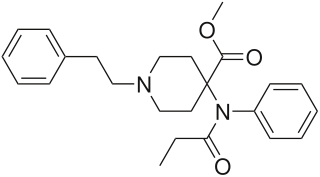
Carfentanil or carfentanyl, sold under the brand name Wildnil, is an opioid analgesic which is used in veterinary medicine to anesthetize large animals such as elephants and bears. It is typically administered in this context by tranquilizer dart. Carfentanil has also been used in humans for imaging of opioid receptors. It has additionally been encountered as an illicit drug, typically used by injection, insufflation, or inhalation. Deaths have been reported in association with carfentanil.

3-Methylfentanyl is an opioid analgesic that is an analog of fentanyl. 3-Methylfentanyl is one of the most potent opioids, estimated to be between 400 and 6000 times stronger than morphine, depending on which isomer is used.

Parafluorofentanyl is an opioid analgesic analogue of fentanyl developed by Janssen Pharmaceutica in the 1960s.

3-Methyl-thiofentanyl is an opioid analgesic and analogue of fentanyl.

3-Allylfentanyl is an opioid analgesic that is an analogue of fentanyl.

Phenaridine (2,5-dimethylfentanyl) is an opioid analgesic that is an analogue of fentanyl. It was developed in 1972, and is used for surgical anasthesia.

Mirfentanil is a fentanyl derivative with strong selectivity for the μ opioid receptor. At lower doses, it antagonizes the analgesic effects of alfentanil and substitutes for naloxone in morphine-treated monkeys; however, it also reverses naloxone-precipitated withdrawal in pigeons trained to discriminate morphine from naloxone.

Butyrfentanyl or butyrylfentanyl is a potent short-acting synthetic opioid analgesic drug. It is an analog of fentanyl with around one quarter of its potency. One of the first mentions of this drug can be found in document written by The College on Problem of Drug Dependence, where it is mentioned as N-butyramide fentanyl analog. This document also states that the article describing its clinical effects was published in 1987. It is an agonist for the μ-opioid receptors.

Acetylfentanyl is an opioid analgesic drug that is an analog of fentanyl. Studies have estimated acetylfentanyl to be fifteen times more potent than morphine, which would mean that despite being somewhat weaker than fentanyl, it is nevertheless still several times stronger than pure heroin. It has never been licensed for medical use and instead has only been sold as a designer drug. Acetylfentanyl was discovered at the same time as fentanyl itself and had only rarely been encountered on the illicit market in the late 1980s. However, in 2013, Canadian police seized 3 kilograms of acetylfentanyl. As a μ-opioid receptor agonist, acetylfentanyl may serve as a direct substitute for heroin or other opioids. Common side effects of fentanyl analogs are similar to those of fentanyl itself, which include itching, nausea and potentially serious respiratory depression, which can be life-threatening. Fentanyl analogs have killed hundreds of people throughout Europe and the former Soviet republics since the most recent resurgence in use began in Estonia in the early 2000s, and novel derivatives continue to appear.

Furanylfentanyl (Fu-F) is an opioid analgesic that is an analog of fentanyl and has been sold as a designer drug. It has an ED50 value of 0.02 mg/kg in mice. This makes it approximately one fifth as potent as fentanyl.

3-Methylbutyrfentanyl (3-MBF) is an opioid analgesic that is an analog of butyrfentanyl.

4-Fluorobutyrylfentanyl (also known as 4-FBF and p-FBF) is an opioid analgesic that is an analog of butyrfentanyl and has been sold online as a designer drug. It is closely related to 4-fluorofentanyl, which has an EC50 value of 4.2 nM for the human μ-opioid receptor.

4-Methoxybutyrfentanyl is an opioid analgesic that is an analog of butyrfentanyl and has been sold online as a designer drug.

Acrylfentanyl (also known as acryloylfentanyl or Egyptenyl) is a highly potent opioid analgesic that is an analog of fentanyl and has been sold online as a designer drug. In animal studies the IC50 or half maximal inhibitory concentration for acrylfentanyl to displace naloxone is 1.4 nM, being slightly more potent than fentanyl itself (1.6 nM) as well as having a longer duration of action.

Methoxyacetylfentanyl, commonly known as MAF is an opioid analgesic that is an analog of fentanyl and has been sold online as a designer drug.

Tetrahydrofuranylfentanyl is an opioid analgesic that is an analog of fentanyl and has been sold online as a designer drug, first appearing in Europe in late 2016.

Orthofluorofentanyl is an opioid analgesic that is an analog of fentanyl and has been sold online as a designer drug. While the structural isomer p-fluorofentanyl was one of the first illicit fentanyl analogues identified in 1981, Orthofluorofentanyl did not appear on the illicit market until August 2016.

Cyclopentylfentanyl is an opioid analgesic that is an analog of fentanyl and has been sold online as a designer drug, mainly in Sweden and other Scandinavian countries.

Isobutyrylfentanyl is an opioid analgesic that is an analog of fentanyl and has been sold online as a designer drug. It is believed to be around the same potency as butyrfentanyl but has been less widely distributed on illicit markets, though it was one of the earliest of the "new wave" of fentanyl derivatives to appear, and was reported in Europe for the first time in December 2012.



















